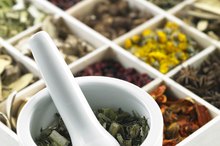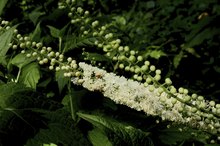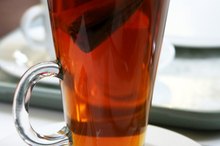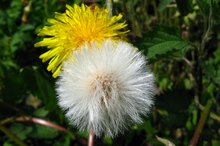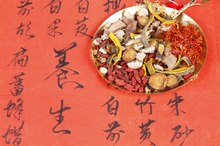What does fact checked mean?
At Healthfully, we strive to deliver objective content that is accurate and up-to-date. Our team periodically reviews articles in order to ensure content quality. The sources cited below consist of evidence from peer-reviewed journals, prominent medical organizations, academic associations, and government data.
The information contained on this site is for informational purposes only, and should not be used as a substitute for the advice of a professional health care provider. Please check with the appropriate physician regarding health questions and concerns. Although we strive to deliver accurate and up-to-date information, no guarantee to that effect is made.
What Is Yellow Root Tea?
Yellow root tea is used in alternative medicine to treat a variety of ailments and conditions. Yellow root has been used medicinally in North America for hundreds of years, currently grown commercially through the United States. With its popularity and production, yellow root is considered endangered in some areas of the country as the demand has exceeded its growth.
If you are experiencing serious medical symptoms, seek emergency treatment immediately.
Identification
Yellow root, commonly known as goldenseal, is a plant that grows wild in parts of the United States and commercially across the country. The U.S. Department of Agriculture lists this root as endangered in many states in the Mid Atlantic, Midwest and Southern regions. The plant grows anywhere from 6 to 14 inches tall with small white flowers and green fruit that turns red in July. Named for its distinct yellow roots, this herb is dried and used to make teas, tinctures, powders, pills and tonics. The Latin name for yellow root is hydrastis canadensis.
- Yellow root, commonly known as goldenseal, is a plant that grows wild in parts of the United States and commercially across the country.
History
What Are the Benefits of Hydrangea Root Herb?
Learn More
An article originally published in the Western Druggist by American Pharmacist John Uri Lloyd indicates the first accounts of yellow root use are linked to the Cherokee Indians, a large North American tribe. Its yellow roots create dye used for baskets and are used medicinally as a bitter tonic in Cherokee medicine. As settlers learned more about Indian use of herbs as a domestic remedy for ailments, yellow root gradually received the attention of the traditional medical community in 1798.
Benefits
According to Internet herbal resources such as Everygreenherb.com, yellow root is sometimes combined with Echinacea as a homeopathic treatment for colds 2. As an anti-inflammatory and natural antibiotic, yellow root tea is used in alternative medicine in the treatment of sinus infections, bladder issues, chest congestion and upper respiratory tract infections. Yellow root tea is considered a liver stimulant and useful in soothing mucus membranes and assisting digestion. While yellow root tea has been noted as a popular remedy for the appearance of drug traces in a urine sample, no scientific or homeopathic research has supported this belief.
- According to Internet herbal resources such as Everygreenherb.com, yellow root is sometimes combined with Echinacea as a homeopathic treatment for colds 2.
- While yellow root tea has been noted as a popular remedy for the appearance of drug traces in a urine sample, no scientific or homeopathic research has supported this belief.
Theories/Speculation
Benefits of Marshmallow Root Tea
Learn More
As alternative medicine, or homeopathy, has grown in popularity, yellow root has become one of the most popular herbs in the United States. With an estimated 250,000 pounds of yellow root sold annually, the price for yellow root by the pound has grown since 1990 and the plant has become endangered in many areas where it once grew wild. In 2006, Janice Boling reporting for the North Georgia News found yellow root pricing grew from $10 a pound to $30 a pound, and in some areas to as much as $100 a pound. As of 2009, yellow root tea is commonly sold as goldenseal tea. It can be purchased online and in local herbal or holistic stores for approximately $10 a box.
- As alternative medicine, or homeopathy, has grown in popularity, yellow root has become one of the most popular herbs in the United States.
- With an estimated 250,000 pounds of yellow root sold annually, the price for yellow root by the pound has grown since 1990 and the plant has become endangered in many areas where it once grew wild.
Warning
While yellow root consumption in tea or other forms is considered safe for short-term use, the National Center for Complementary and Alternative Medicine has indicated there is no general information available about the safety of high dosages or long-term use 3. While used in alternative medicine to treat a variety of ailments, there is little scientific evidence from the traditional medical community to support many of the health benefits noted here. Yellow root or goldenseal should be avoided during pregnancy or if you have high blood pressure. It is recommended that individuals consult a physician before using herbal remedies to treat serious conditions.
- While yellow root consumption in tea or other forms is considered safe for short-term use, the National Center for Complementary and Alternative Medicine has indicated there is no general information available about the safety of high dosages or long-term use 3.
Related Articles
References
Writer Bio
CL Hardy is a communication professional based in Austin, Texas. In addition to writing corporate newsletters, proposals and technical white papers for Fortune 500 clients for more than 12 years, Hardy has been published in "Black Collegian" magazine; her articles on human resources, business and art topics can be found on eHow. She graduated from the University of Pennsylvania with a B.S. in communication.


